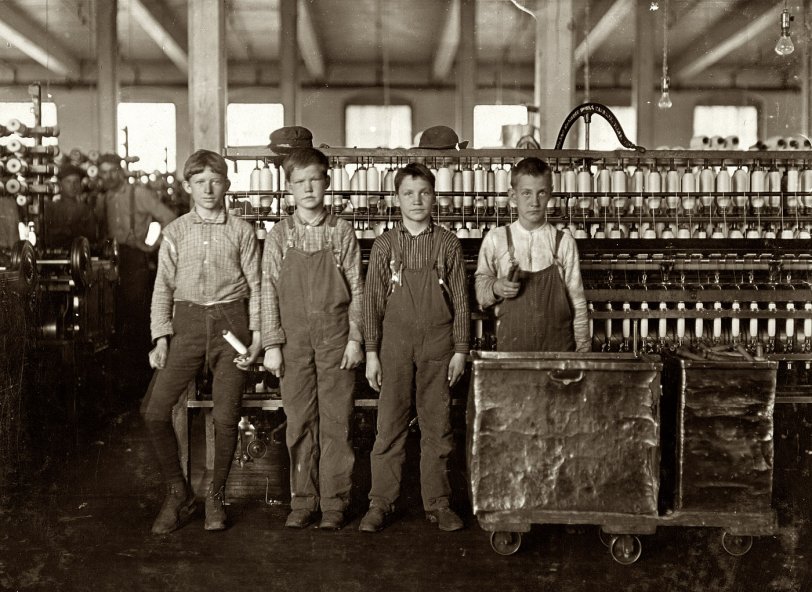


Framed or unframed, desk size to sofa size, printed by us in Arizona and Alabama since 2007. Explore now.
Shorpy is funded by you. Patreon contributors get an ad-free experience.
Learn more.

- Details, Details
- What's that building to the left of the tower?
- Coal Barges
- Bromo-Seltzer
- Inner harbor
- The Basin
- What a headache!
- Giant stepladder?
- Baldwin 62303
- Baldwin VO-1000
- Cold
- No expense spared
- Tough Guys
- Lost in Toyland
- And without gloves
- If I were a blindfolded time traveler
- Smoke Consumer Also Cooks
- Oh that stove!
- Possibly still there?
- What?!?
- $100 Reward
- Freeze Frame
- Texas Flyer wanted
- Just a Year Too Soon
- WWII -- Replacing men with women at the railroad crossing.
- Yes, Icing
- You kids drive me nuts!
- NOT An Easy Job
- I wonder
- Just add window boxes
Print Emporium
Four Doffers: 1908

November 1908. Cotton mill workers at Daniel Manufacturing Co. in Lincolnton, North Carolina. Four doffers. Boy on left end (knee pants) said he had worked in the mills for seven years and some nights. At nights they work 12 hours, without any hour off for lunch. Eat when they can. Some of them "eat a-workin'." Photograph and caption by Lewis Wickes Hine. View full size.
English industrial folk song "Doffing Mistress"
Oh do you know her or do you not
This new doffing mistress we have got?
Elsie Thompson it is her name
And she helps her doffers at every frame.Chorus (after each verse):
Fol de ri fol ra
Fol de ri fol rayAnd Monday morning when she comes in
She hangs her coat on the highest pin.
Turns around just to greet her friends,
Crying, “Hi, doffers, tie up your ends!”Some times the boss he looks in the door,
“Tie your ends up, doffers,” he will roar.
Tie our ends up we surely do,
For Elsie Thompson but not for you.
(Anne Briggs version)
Doffers at Lincolnton.
Doffers were called to remove finished work [bobbins wound with thread or yarn] by alarm bells serving their machines. It was irregular work in that they were doffing about 15 to 20 minutes out of each hour. Commonly they could be seen around the back doors and on staircases around them, where they played around. The Lincolnton mill owners (or at least some of them) were somewhat backward from evidence discussing Mill Schools that you can find in the Southern Historical Collection at UNC Chapel Hill. These kids would have gotten six months of schooling for a minimum of five hours a day at mill expense.
Children under 6 received day care in nursery schools so their parents could work. Cannon and Irwin among the more enlightened mill owners provided eight months of six hour schooling. In any case boys working all night would have been a spring-summer phenomenon (i.e. when schools were
not in session).
The state of North Carolina providing public schooling for non-mill kids was a sometime thing. In 1910 the state provided 11 cents per annum per schoolchild. Under these conditions rural farm children were commonly offered two months of schooling on a traditional 9 a.m.-4 p.m. day. If seasonal farm work interfered with this so be it. Teachers operated upon a circuit for the most part moving from all-in-one grade schools on two monthly cycles.
By the time of the Great War the school year in market towns was three months, and in most cases the teacher stayed in a location while the classes moved through their three month year, and grades 1-3 always came in at fall harvest time so that field harvesters would be available from the older children.
Thus the doffers had an educational advantage not available to their working-class white contemporaries. The middle class children in the mass of N.C. towns would attend privately operated schools. In cities like Greensboro, Winston and Raleigh there were full-season public schools, where clothing and supply costs precluded the poor from attending. In other words like the state university they were set up with inherent barriers to exclude the poor, while using tax funds to allow the middle and upper class to obtain favored services from the state. It was what an oligarchy is all about.
However, the mill schools provided the foreman and clergymen to their community. The brightest graduates obtained scholarships provided by various Episcopalian and Methodist missionary boards, mill company benefit societies and veterans organizations that allowed them to provide the doctors, lawyers, CPAs and professional and management classes that held this society together.
Good luck, and remember the doffers were the lucky ones in the mass of Southern working class people.
-- Peter Boylan
























On Shorpy:
Today’s Top 5